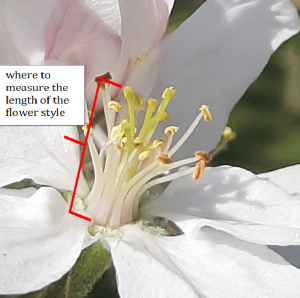Tree Fruit Newsletter — May 20, 2024
In this newsletter:
- Highmoor Farm Bud Stages
- Chemical Thinning at Petal Fall
- Bloom thinning using lime sulfer
Highmoor Bud Stages
McIntosh apples – king bloom
Honeycrisp apples – late in the pink stage
Pears – full bloom
Sweet and sour cherries – full bloom
Peaches and Plums – full bloom and petal fall depending on variety
Apricots – jacket stage, early fruit set
Chemical Thinning at Petal Fall
There have been no reports of frost or freeze damage to apples in Maine, so anticipate the need for chemical thinning. Most of my orchards have a good amount of bloom and have had good pollination weather which is expected to continue. Forecasted high temperatures will be warm enough for effective thinning beginning Monday when some orchards will at petal fall. Petal fall occurs when 80% of the petals have dropped.
At petal fall, fruitlets increase in sensitivity to chemical thinners. A thinner applied at this stage is early enough to see the effects when there is still enough time to apply another thinner, if needed. These are some of the chemical thinners that can be used at petal fall:
Carbaryl, but avoid using this if bees are still in the orchard
NAA (Fruitone, PoMaxa and others) alone or with Carbaryl
NAD (Amid-Thin) alone or with Carbaryl
6-BA (Maxcel, Riteway) alone or with Carbaryl
ABA (Protone), if available
Protone is a new thinner for apple and pear that can be applied beginning when fruit reach a diameter of 5 mm and up to 20 mm. It is OMRI-listed for organic orchards. Not much is known yet about how well it works in our region, and it may not be available yet in Maine. Here is a link to the product label: ProToner_SG1ji_Plant_Growth_Regulator_Label.pdf
For more info on chemical thinning, check out the New England Tree Fruit Guide: Chemicals for Apple Thinning | New England Tree Fruit Management Guide (netreefruit.org)

Bloom Thinning Using Lime Sulfur and the Pollen Tube Growth Model
For organic orchards, lime sulfur will thin fruit when applied after king bloom to burn the remaining unpollinated flowers. The lime sulfur spray is timed to go on after enough flowers have been pollinated. A more precise timing of this spray can be based on the time it takes for pollen to grow down the floral tube or style where it can fertilize the eggs. The NEWA website has this calculation set up under the “Pollen Tube Growth Model”. Record the date when enough king blooms have opened for a full crop. You also need to measure how long the flower styles are for each variety (see photo below). Style length ranges from 8 to 14 mm depending on variety. Honeycrisp flowers at Highmoor Farm have an average style length of 10 mm. Gala has a length of 13 mm. Styles are green in contrast to the white stamens which usually differ in length from the style. When date and style length are entered in the model, it will indicate the date when lime sulfur or any other caustic bloom thinner should be applied which is presumably when pollen has grown down the style and has fertilized the eggs.
Apple Pollen Tube Growth Model | NEWA (cornell.edu)
Lime sulfur can russet fruits when applied after bloom. Check the label for OMRI certification.
An article that explains the pollen tube growth model for bloom thinning:
Peck-Pages-from-NYFQ-BOOK-WInter-2018.1-27-19-4.pdf (nyshs.org)
Renae Moran
UMaine Cooperative Extension Tree Fruits Program
University of Maine Cooperative Extension
PO Box 179
Monmouth, ME 04259
(207) 933-2100
rmoran@maine.edu
Mention of a trademark, proprietary product, or vendor does not constitute a guarantee or warranty of the product, nor does it imply approval or disapproval to the exclusion of other products or vendors that may also be suitable.
In complying with the letter and spirit of applicable laws and pursuing its own goals of diversity, the University of Maine System does not discriminate on the grounds of race, color, religion, sex, sexual orientation, transgender status, gender, gender identity or expression, ethnicity, national origin, citizenship status, familial status, ancestry, age, disability physical or mental, genetic information, or veterans or military status in employment, education, and all other programs and activities. The University provides reasonable accommodations to qualified individuals with disabilities upon request. The following person has been designated to handle inquiries regarding non-discrimination policies: Director of Equal Opportunity, 5713 Chadbourne Hall, Room 412, University of Maine, Orono, ME 04469-5754, 207.581.1226, TTY 711 (Maine Relay System).
